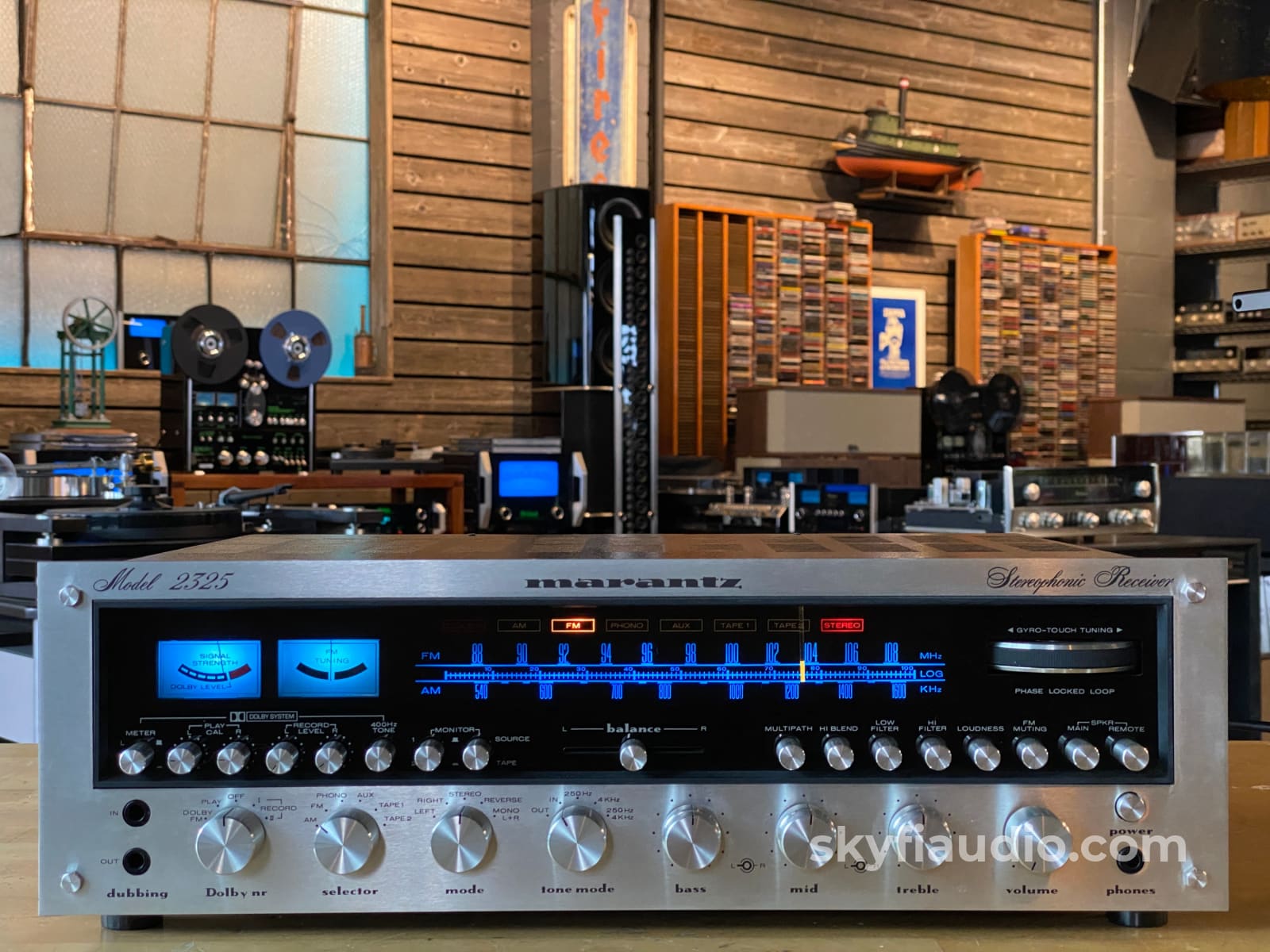
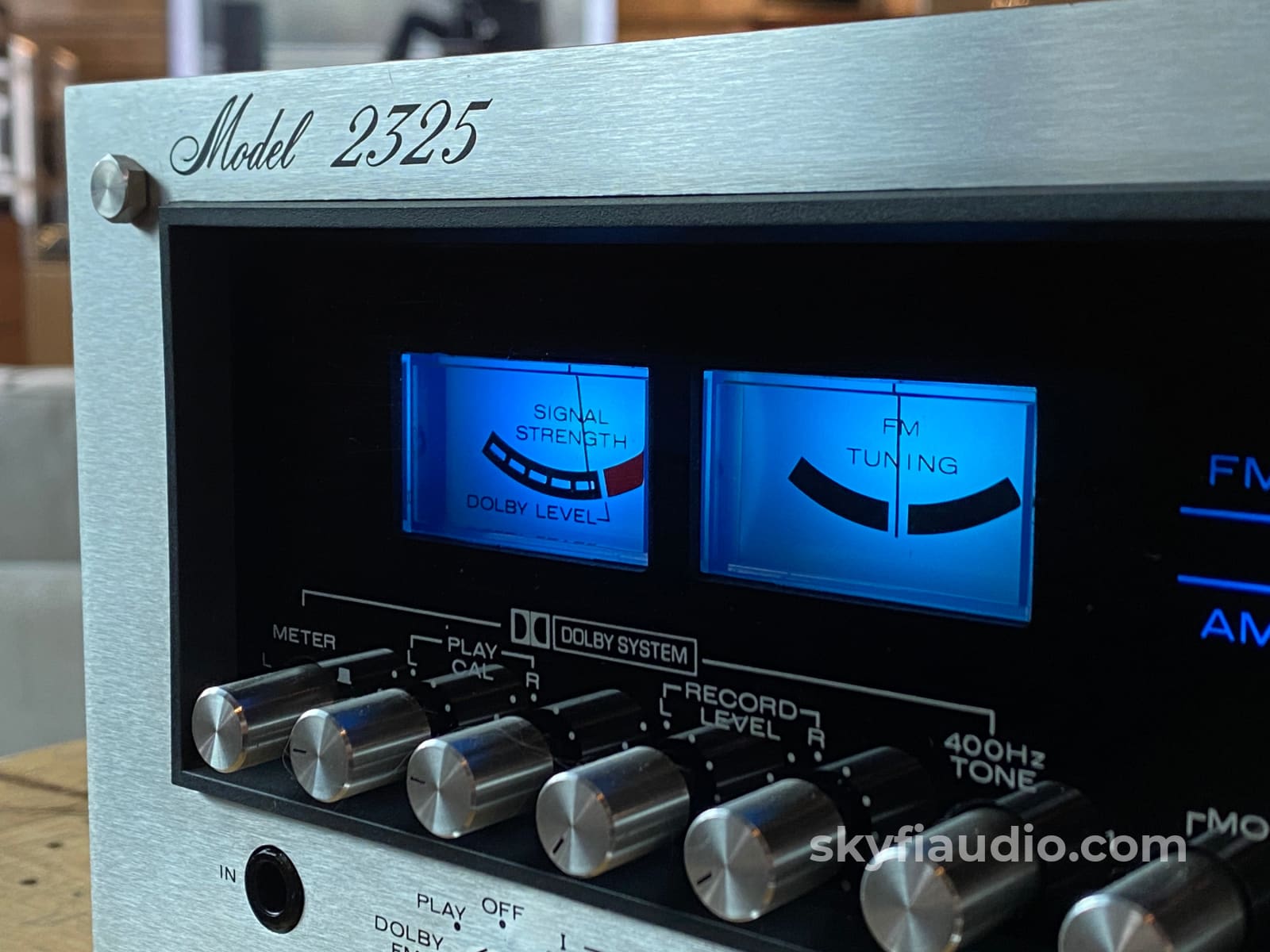
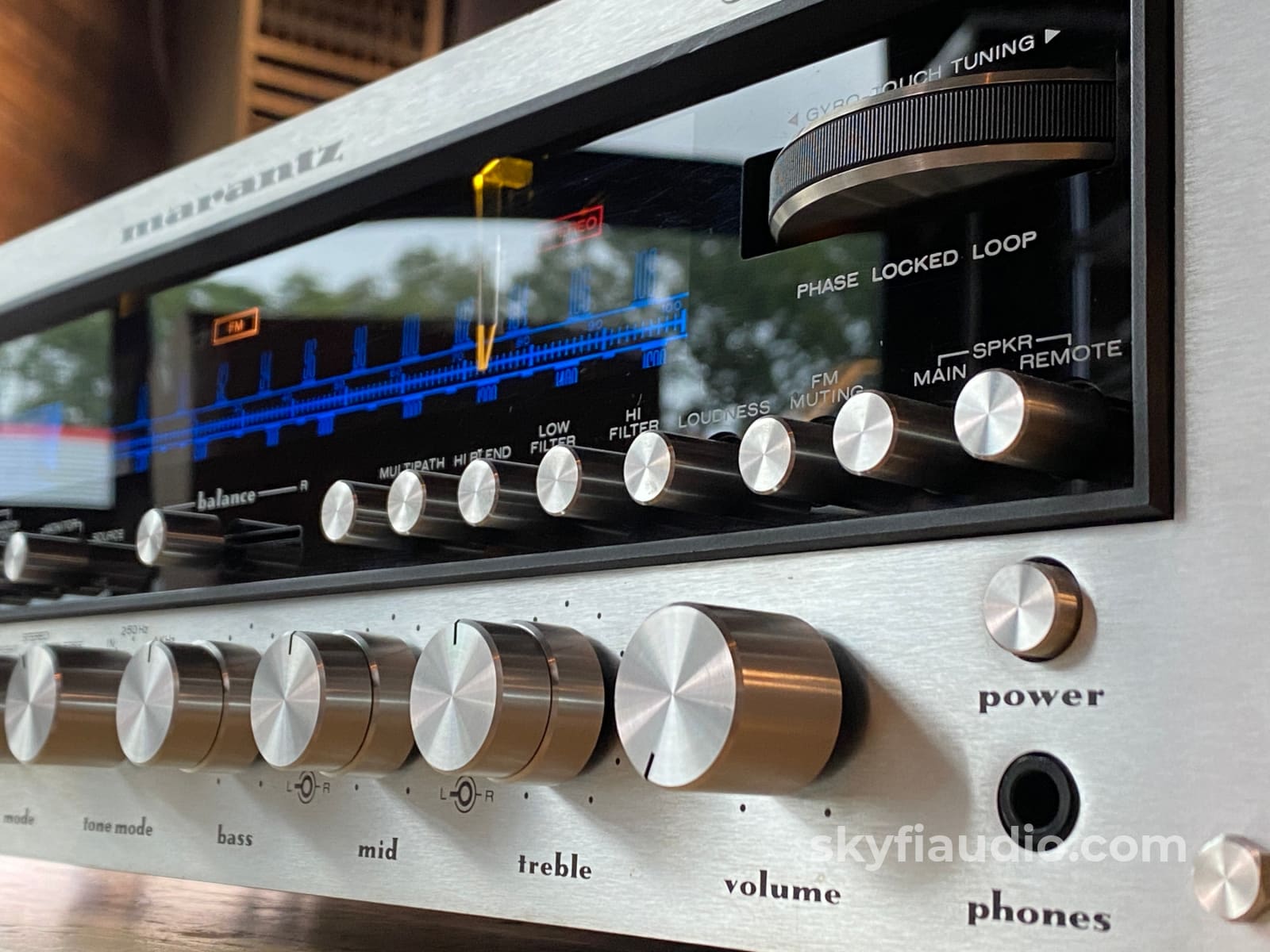
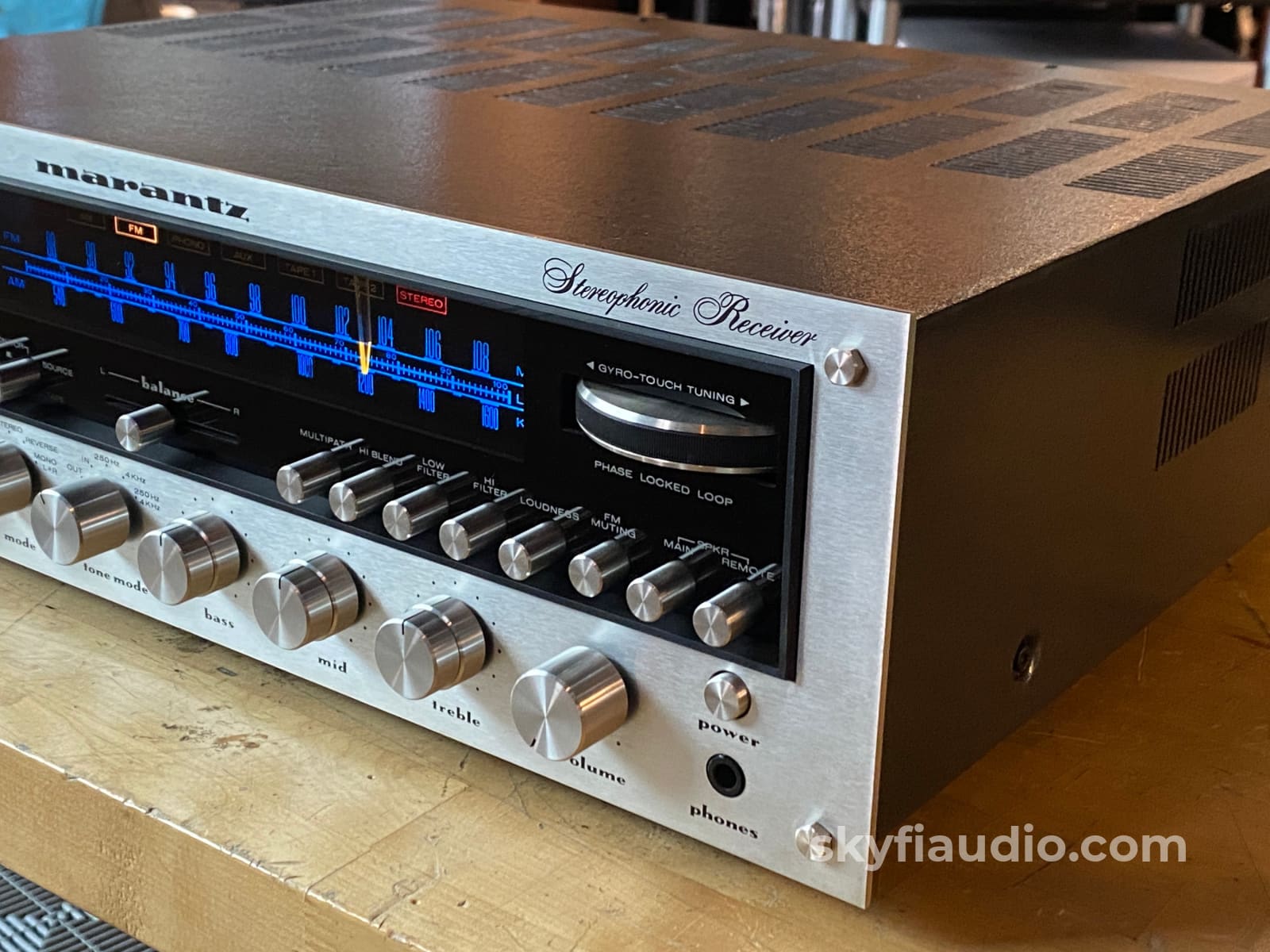
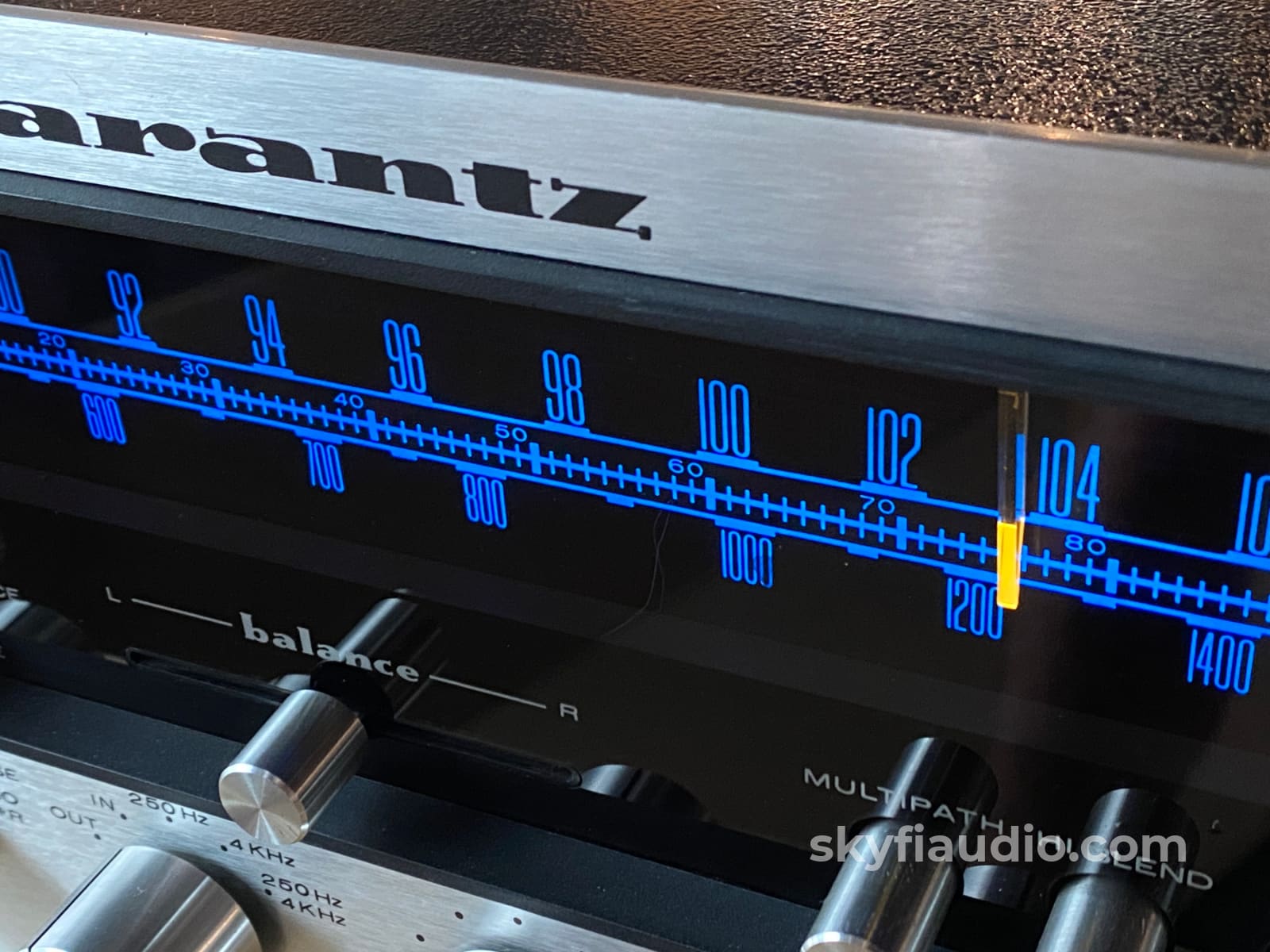
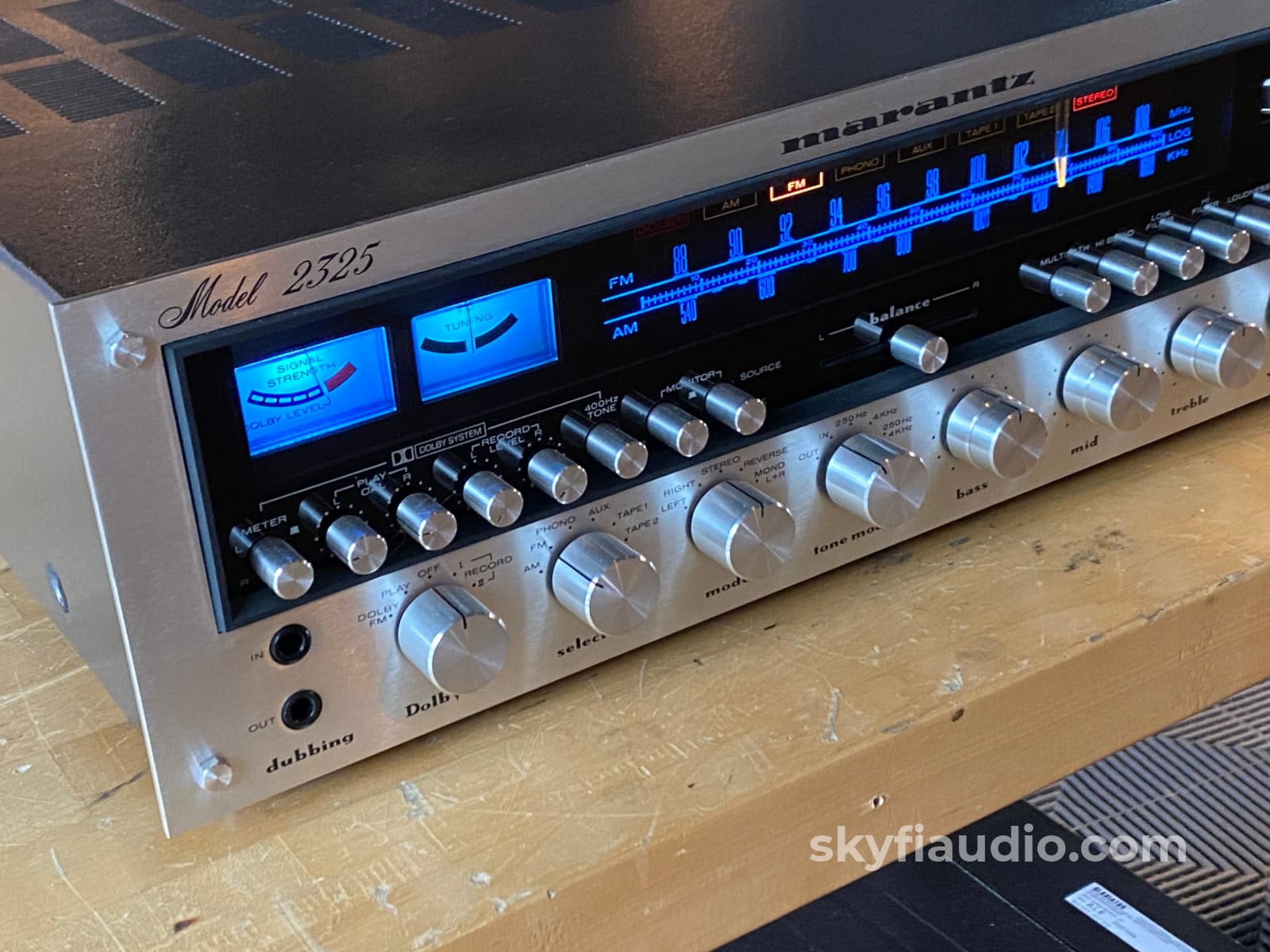
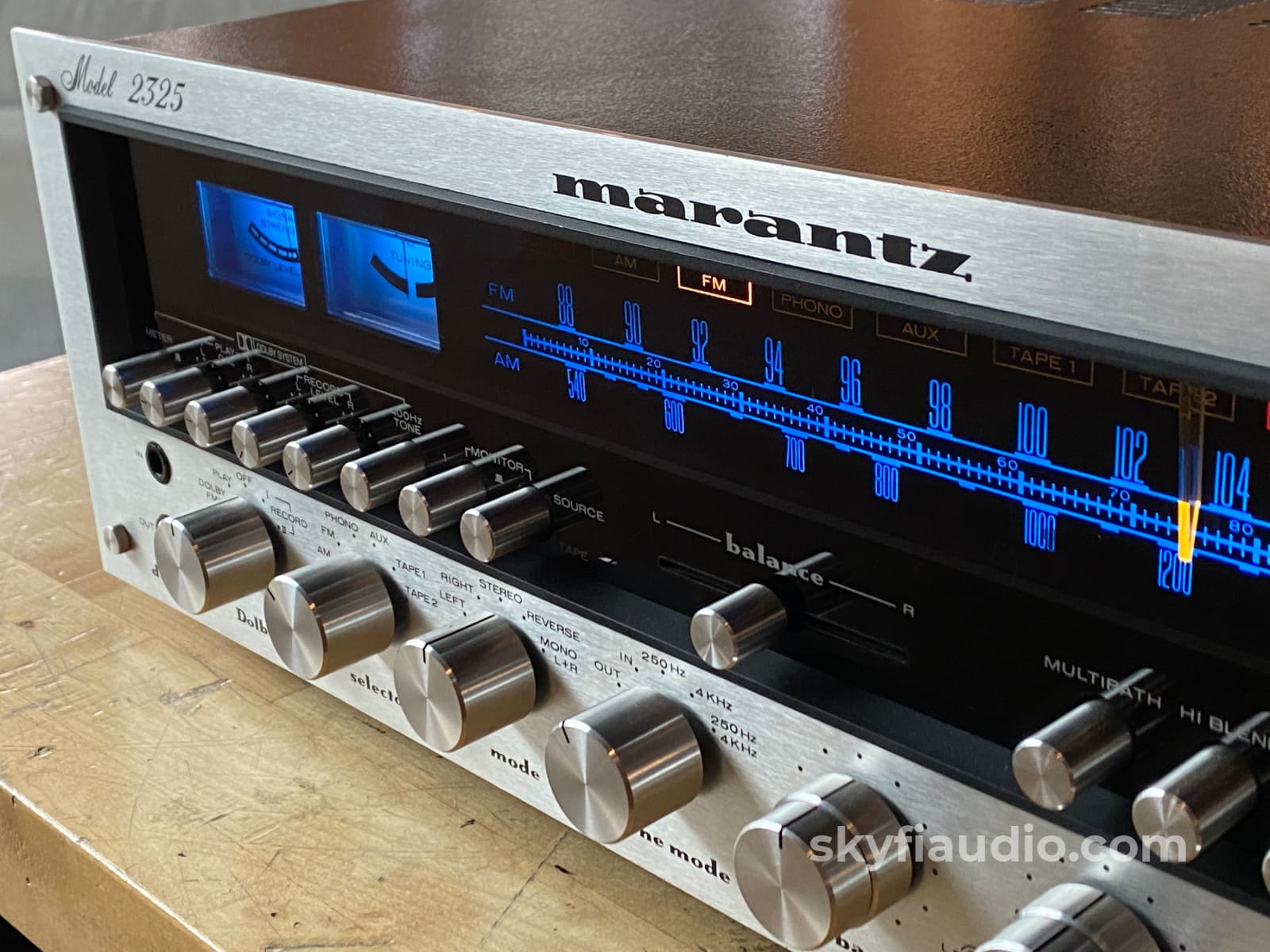
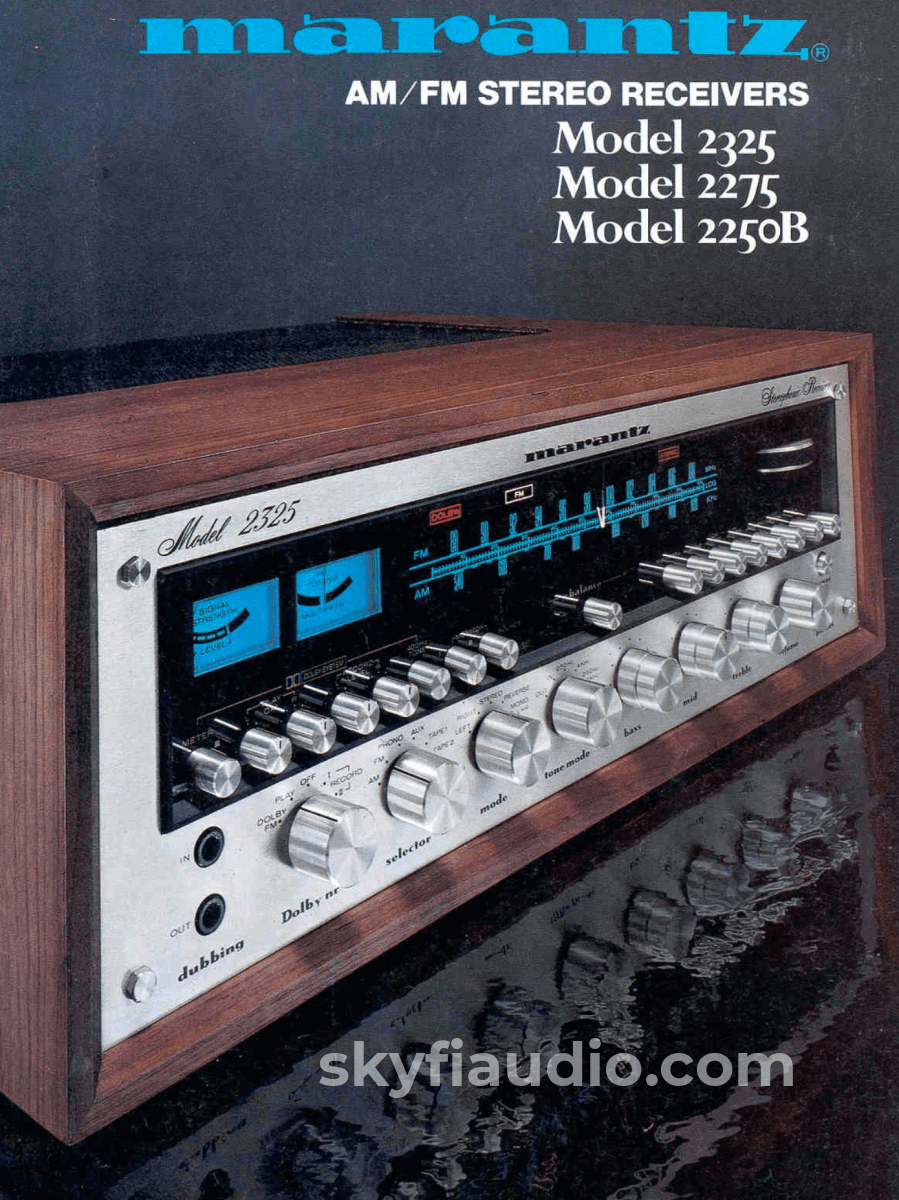
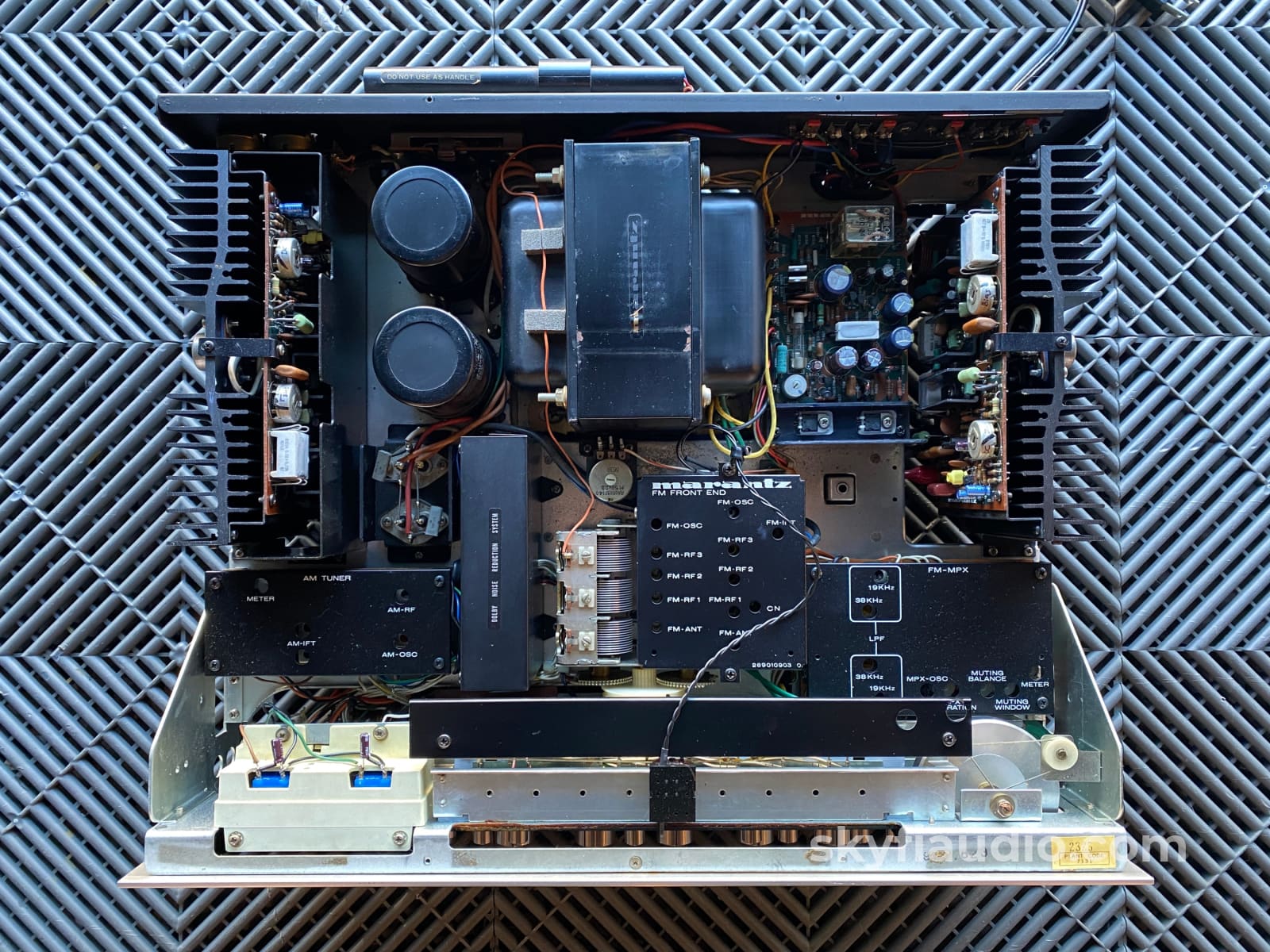
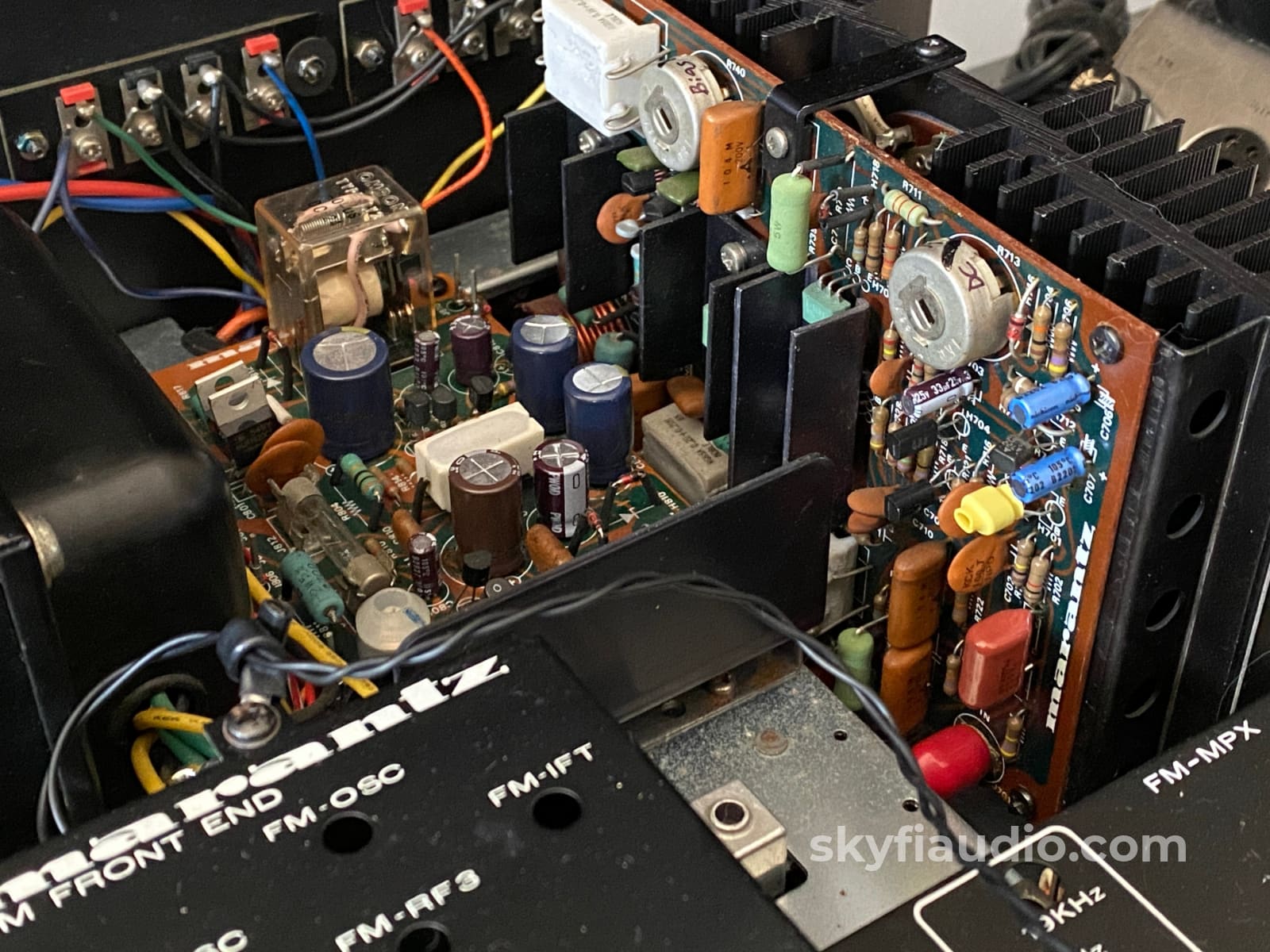
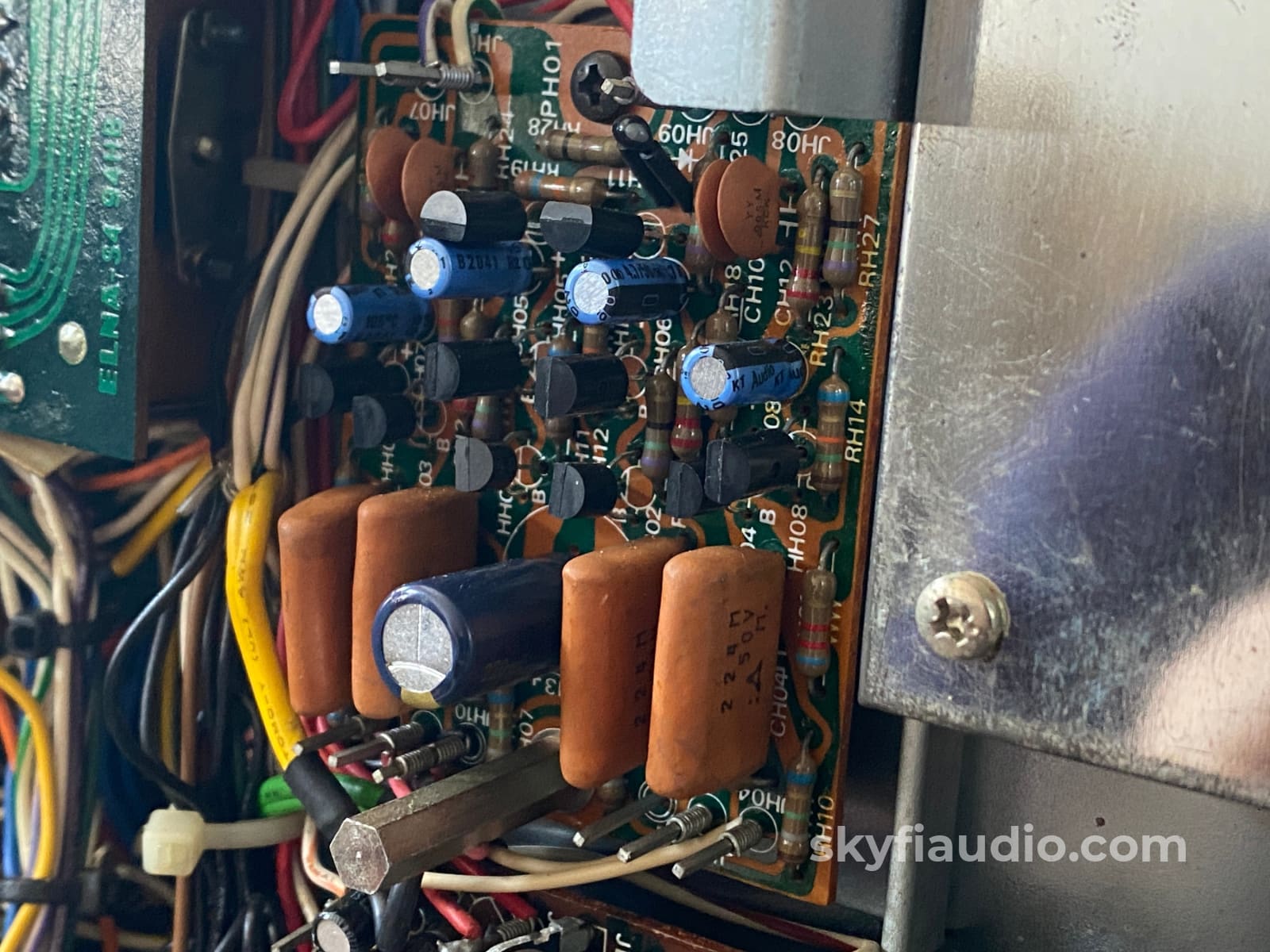
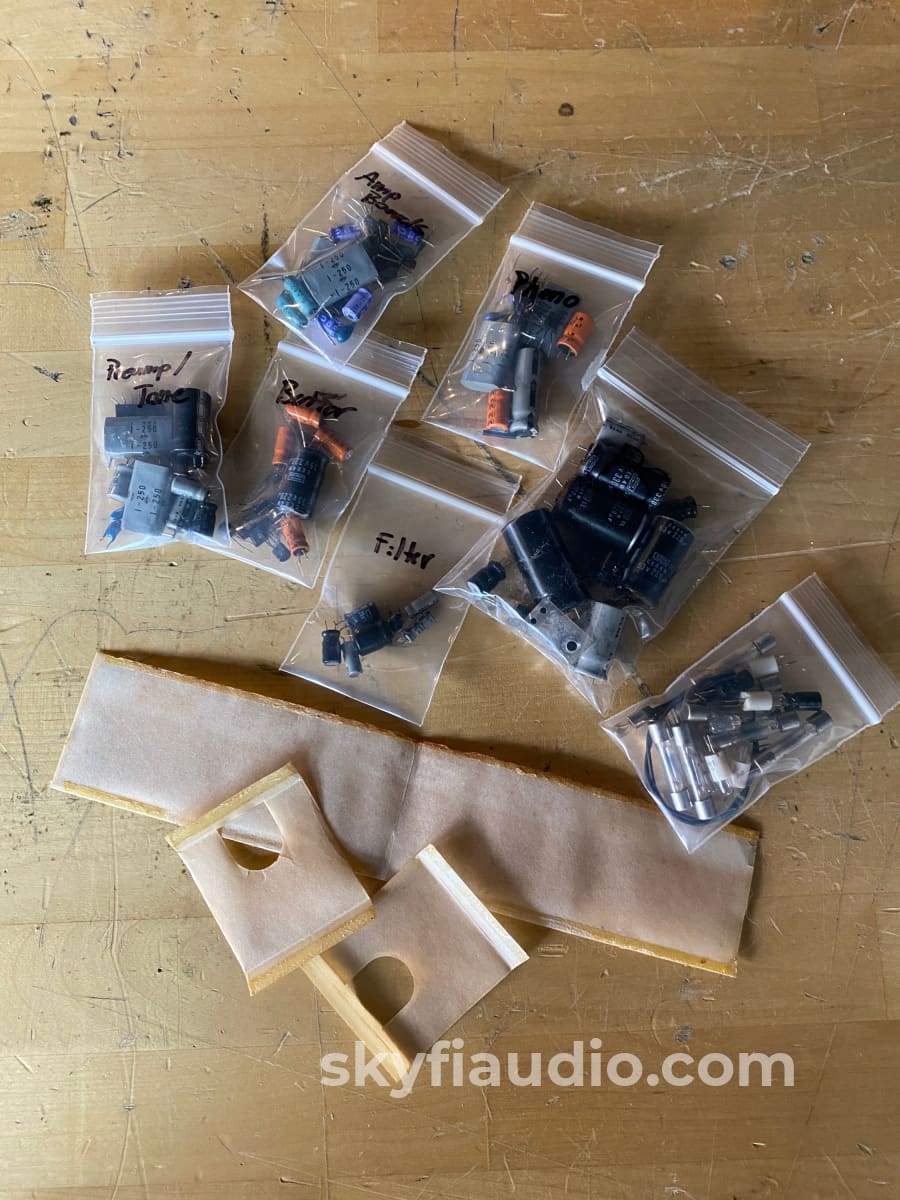
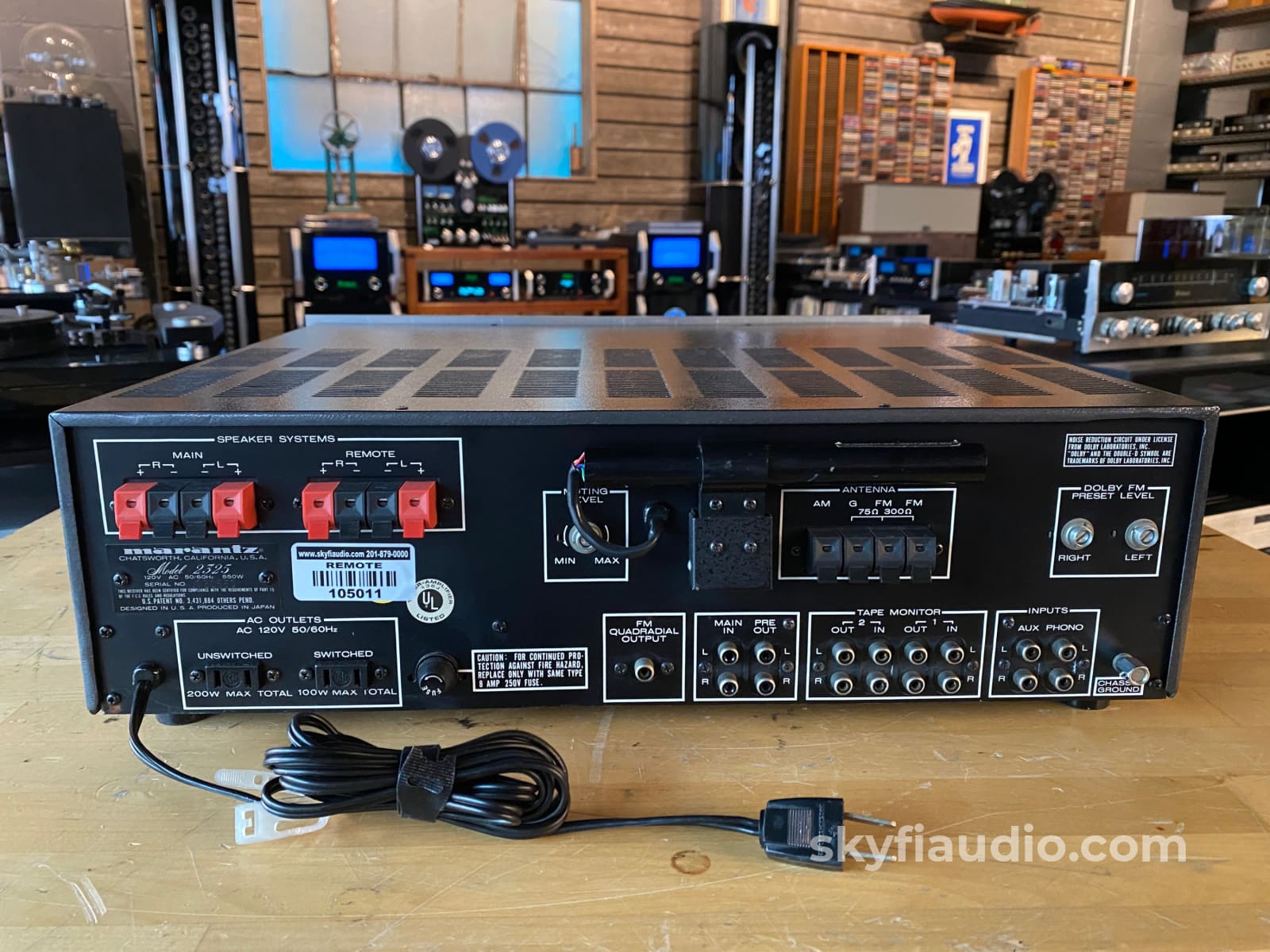
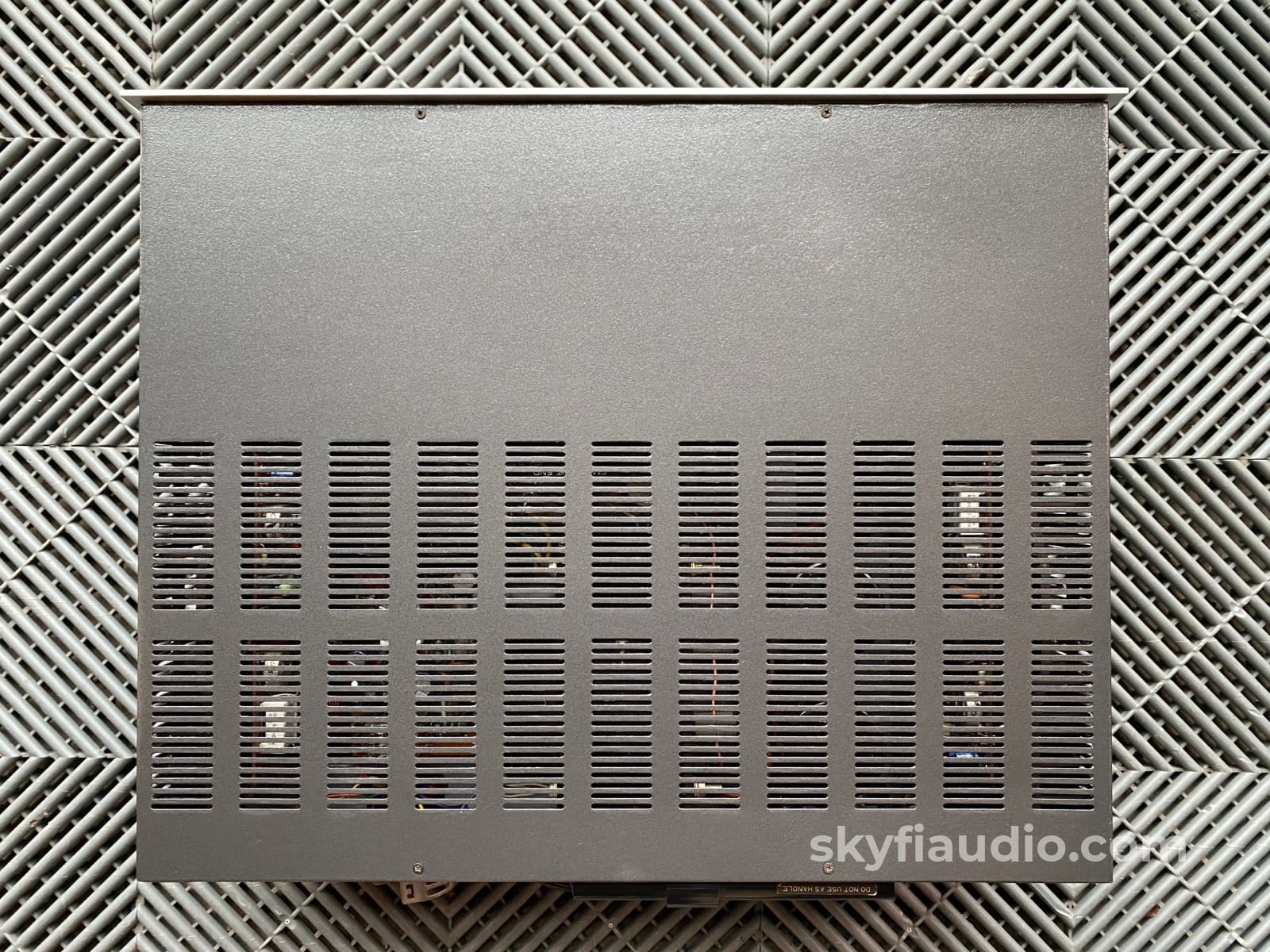
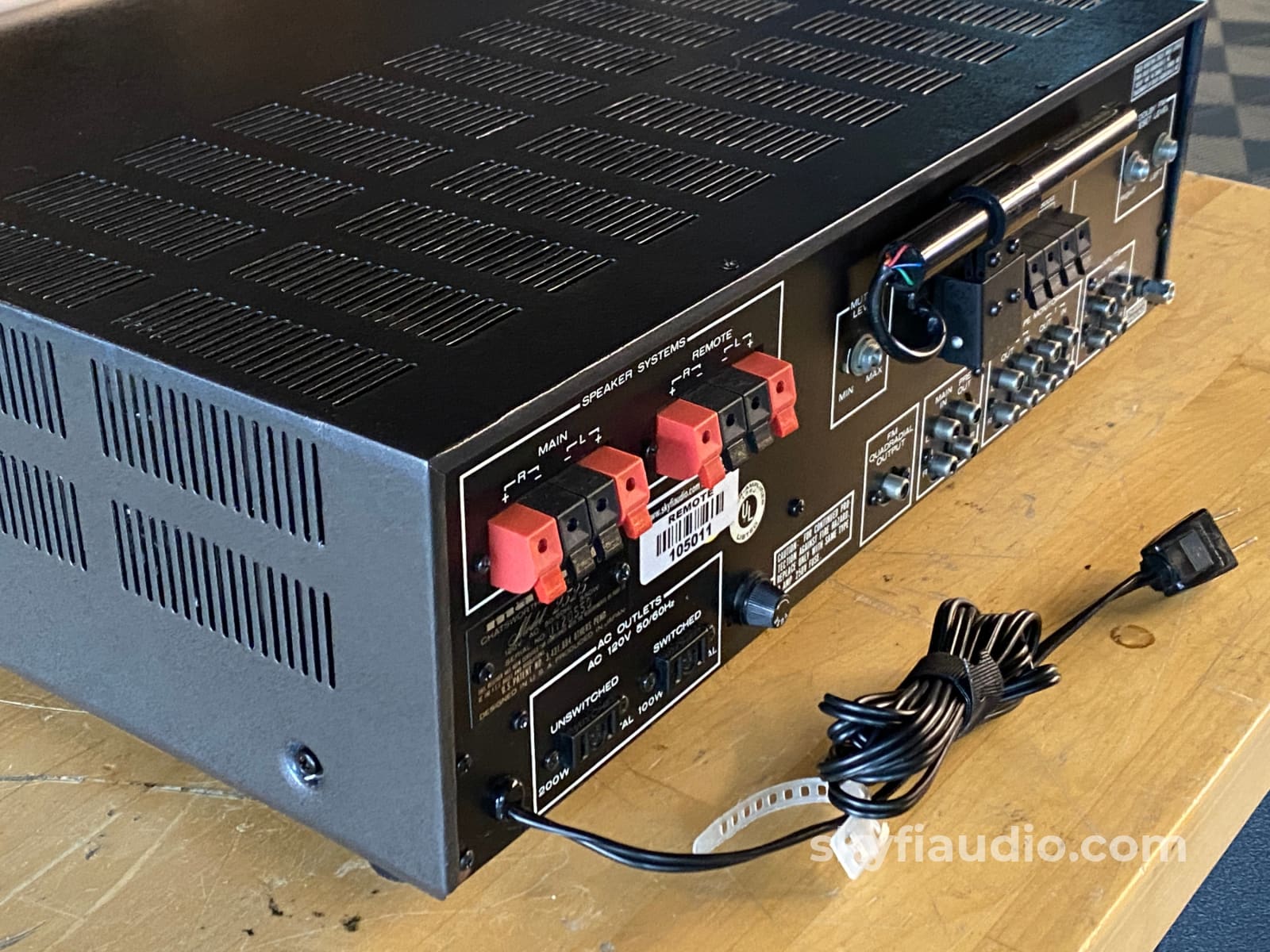
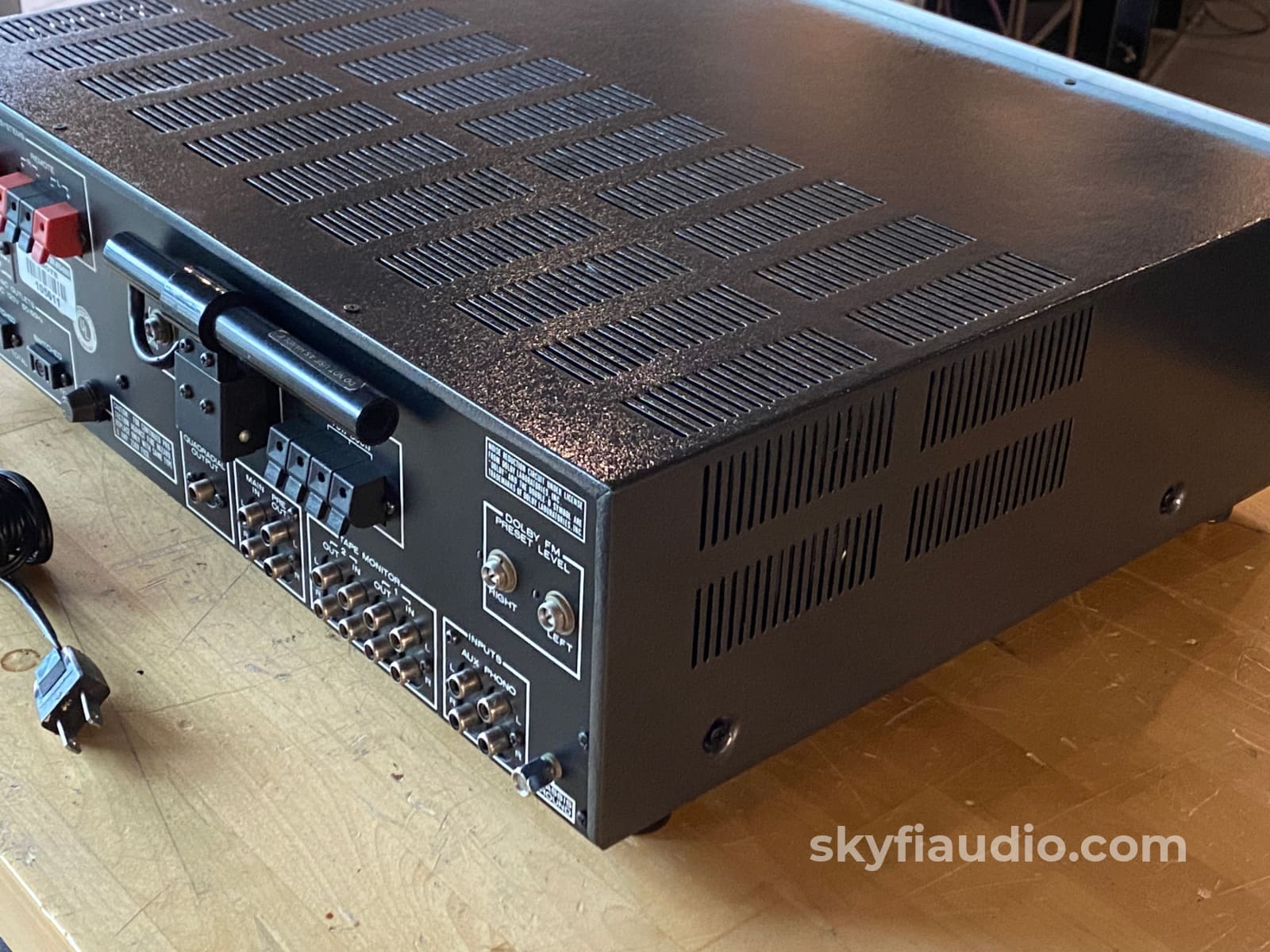
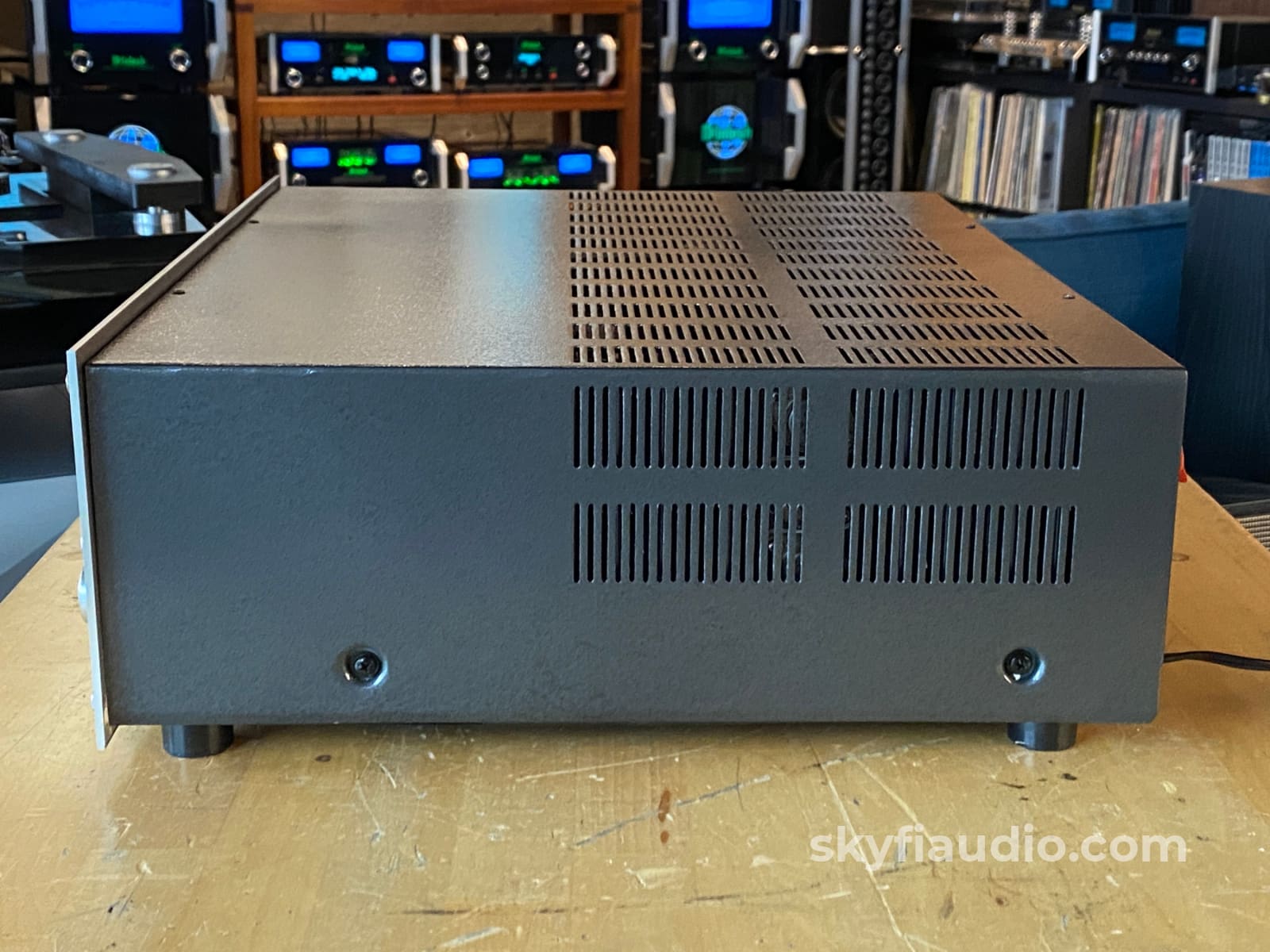
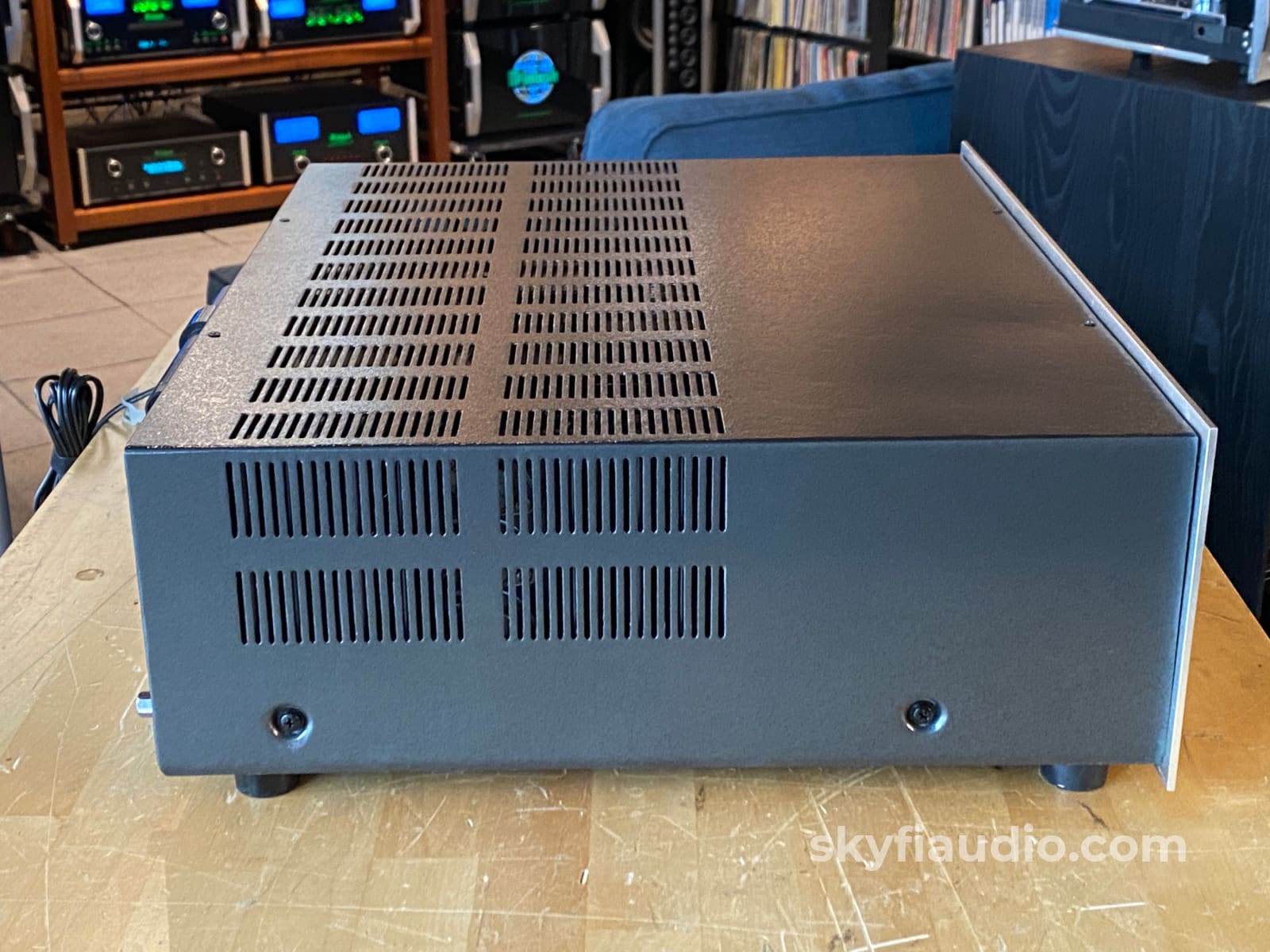
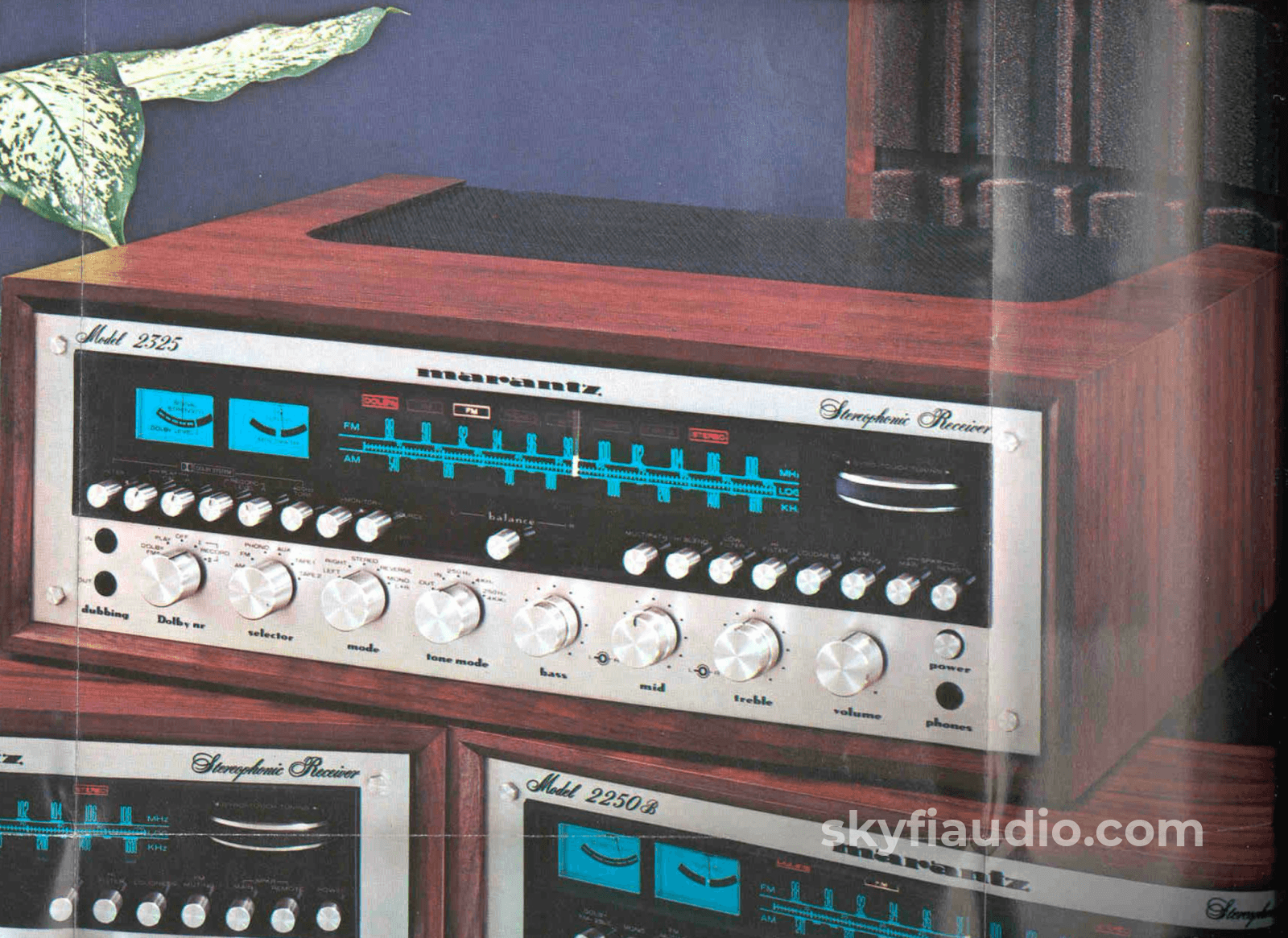
Marantz 2325 Vintage "Stereophonic Receiver" - Full SkyFi Restoration
Free Shipping on Most Electronics - Excludes Speakers and Items Requiring Freight - Contiguous U.S. Only
Pickup currently unavailable at SkyFi 479

Marantz 2325 Vintage "Stereophonic Receiver" - Full SkyFi Restoration
SkyFi 479
479 South Broad Street
Glen Rock NJ 07452
United States
General:
SkyFi Restoration Notes:
This Marantz 2325 underwent an extensive in-house restoration here at SkyFi. The scope of the restoration was to make the unit look beautiful again while making it reliable for the long term.
For the electronic portion of the restoration we focused on the most important audio circuity. The power supply, preamp, phono stage, and power amp sections have all been fully addressed.
We also checked over the dolby and tuner circuits to verify proper function but have not opted for bulk parts replacement in those sections.
Below is an outline of all of the work that was performed.
Power Supply:
- All electrolytic capacitors replaced.
- Rectifier diodes replaced with improved components.
- Regulator pass transistors replaced with new silicon devices with higher heat tolerance, thermal compound refreshed.
- Protection relay removed, contacts cleaned, and reinstalled.
Phono Stage:
- All known troublemaker transistors and diodes replaced.
- All electrolytic and tantalum capacitors replaced.
- 1uF capacitors upgraded to polypropylene film.
Preamp / Tone Control Board:
- All known troublemaker transistors replaced.
- BA312 ICs replaced with more reliable discrete replacements.
- All electrolytic and tantalum caps replaced.
- 1uF capacitors upgraded to polypropylene film.
Buffer Amplifier:
- Known troublemaker transistors replaced.
- All electrolytic capacitors replaced.
Power Amplifier Boards:
- Differential input pairs replaced with matched components and have been thermally coupled for more reliable DC offset tracking.
- All electrolytic and tantalum capacitors replaced.
- Known troublemaker transistors replaced.
- 1uF capacitors upgraded to polypropylene film.
- Overheated 1.2K resistors upgraded to 5W parts with better heat handling capability.
Illumination:
- Main dial lamp housing replaced.
- All indictor lamps replaced.
- Dial and meter lamps replaced with warm white LED.
- Dial and meter vellum paper replaced.
- Dial pointer replaced with LED.
Additional:
- All electrolytic and tantalum caps replaced on filter board.
- Faceplate, knobs, and chassis cleaned and detailed.
- Main filter capacitors removed from circuit and tested for Value, ESR, and Leakage - PASS.
- All controls cleaned.
Service Manual Alignment:
- Regulated power supply voltage set.
- DC offset and Bias set on both amplifier channels.
- Phono distortion calibration completed.
- FM tuner aligned.
- AM tuner aligned.
- NOTE: No Dolby alignment was performed.
Testing:
- All controls tested for proper function.
- Tuner sensitivity, stereo, dial tracking PASS.
- Rated power check 125W into 8 ohms both channel driven PASS.
- THD Check PASS.
Cosmetic Notes:
- This unit came to us with a damaged wood vinyl wrapped top cover. We have removed the original wrap and painted the cover with a hammered dark gray enamel.
- Dial is lettering is a bit distorted around the 1000AM mark.
Ownership:
Unknown
Connections:
RCA Jacks for Inputs and Outputs, Spring Loaded Speaker Terminals, Captive Power Cord,
General Sound:
Big beautiful musical sound with little fatigue.
Cosmetic Condition:
7/10 = Good. One or two minor scratches. Well Maintained. See our detailed rating description here.
Working Condition:
Working perfectly and tested in our lab and listening room.
Included:
Just the unit and its captive power cord.
Packing:
Will be packed using our highly developed in-house process and custom packing materials.Reviews:
Click Here
Original MSRP:
$799.95 in 1974. Equals $5.000 today when adjusted for inflation.
Specs:
Please click the owner's manual or sales brochure links below.
Dimensions:
19-15/16 x 5-3/4 x 15-3/16 inches
Weight:
50 lbs.
Approximate Age:
1976
Link to Manual:
Click Here
Link to Original Sales Brochure:
Click Here
Recommended Cables:
Kimber Kable - RCA Interconnects - Better
Kimber Kable - RCA Interconnects - Best
Kimber Kable - Phono Interconnects - Better
Kimber Kable - Flagship Phono Interconnects - Best
Kimber Kable - Speaker Cables - Good
Kimber Kable - Speaker Cables - Better
Kimber Kable - Bi-Wire Speaker Cables - Best
Testing Process:
We start with a visual inspection of all internal components to make sure that there are no signs of heat stress or damage. Capacitors are checked for telltale signs of predictive failure including bulging, shrunken wrappers, or physical leakage. We also inspect the PCBs for discoloration from resistors or transistors that may have been running hot. On vintage units we often spot check select capacitors for value and ESR.
If the device has the ability to decouple the preamplifier from the power amplifier, we remove the jumpers and independently test each section. If the device cannot be decoupled, we assess the electronic condition of the piece by analyzing the speaker level output only.
We start by connecting the “preout” jacks of the receiver to a Sencore PA81 Power Analyzer which simulates real world loading conditions and gives us an oscilloscope interface. The first order of business is checking that the volume control works smoothly throughout its entire range with acceptable channel balance. This is accomplished by feeding a 1KHz sine wave into one of the preamp’s line level inputs while monitoring the preamp’s output on an oscilloscope. We then switch to a 1KHz square wave to test the tone controls, loudness function, and filters where applicable. During this step we are watching for equal alteration of the test signal by both channels. This also helps us identify dirty controls that will need treatment. Once the basic line stage functions are verified, we test each input individually. This is especially important for devices that use relays to select their sources.
If the preamp section is equipped with a phono stage we test that as well. We use an inverse RIAA filter which allows us to feed a reference test signal into the phono input with the proper RIAA equalization and level. A square wave or sine sweep is used to verify that the device’s phono stage is faithfully reproducing the RIAA curve.
To test the tuner, we connect one of the tape outputs to the Sencore PA81 and the antenna terminals to a Sencore SG80 which allows us to “simulate” an ideal radio station using precision test signals instead of music. This device, in conjunction with an oscilloscope allows us to properly evaluate the following parameters:
- AM Reception (Where Applicable)
- FM Mono Reception & Tuning Meter Function
- FM MPX Reception (Stereo)
- Dial Tracking - How accurately the tuner dial or display indicates the actual frequency of the broadcast being received.
- Stereo Separation - A properly working stereo tuner will have minimal crosstalk between the left and right channel.
- Sensitivity & Signal Strength Meter Function - By lowering the output of the SG80 we can simulate weak stations and determine how well the tuner will be able to pull in weak distant stations. This adjustment also helps us verify signal strength meter function.
If the tuner has acceptable performance related to the parameters above, we connect the unit for listening tests with a simple dipole antenna. We listen for audio reproduction quality of local stations and evaluate how many stations the tuner can receive while we sweep through the dial. We are looking to verify that the tuner can decode stereo on strong local broadcasts and pick up a wide variety of local stations at the bottom, middle, and top of the frequency band. At this point we also test convenience features such as muting, filters, built in oscilloscope function, etc.
Next, we test the power amplifier section by connecting the receiver’s speaker outputs to a Sencore PA81 Power Analyzer which acts as a dummy load, DC offset monitor, and oscilloscope interface. We start with a low level 1KHz test signal at the “main in” jacks and slowly increase its amplitude while monitoring the output on an oscilloscope for signs of noise, clipping, distortion, or improper channel balance. We continue increasing the signal level until the amplifier reaches clipping. At this point we take an output power measurement and compare it to the spec sheet of the amplifier to verify proper performance.We finish off the bench evaluation with a 1KHz square wave check and a 20Hz to 20KHz sine sweep to assess the amplifier’s frequency response characteristics. This battery of tests will usually reveal if the amplifier has any issues that need further attention.
If the preamp and power amp both pass these tests, we reconnect the sections and verify that the preamp section can drive the power amp to rated power with a 1KHz tone on one of the line level inputs.
Before the device leaves the bench, we perform a listening test with actual music using a variety of preferred test tracks. Our benches are outfitted with familiar monitor speakers which help us identify inconsistencies that will not always show up on our test gear. The main things that we are listening for are hum or noise with no signal present, proper center image, clicks, pops, or any other obvious undesirable audio characteristics.
If the unit passes all of these tests it is moved to our long term testing rig where we simulate real word operating conditions for 6-8 hours. This allows us to monitor the unit for signs of thermal runaway or intermittent issues that only crop up when the unit has fully come up to temperature.
Choose options
